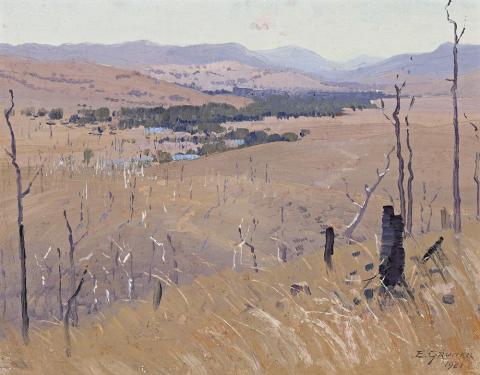SCENE AT MAIDENHEAD, NEW ENGLAND, 1921
ELIOTH GRUNER
oil on canvas on board
28.5 x 36.0 cm
signed and dated lower right: E. Gruner / 1921
Private collection
James R. Lawson, Sydney, 23 November 1926, lot 169
Private collection, Sydney
Thence by descent
Christie’s, Sydney, 23 August, 2004, lot 10
Roger Langsworth, Sydney
Elioth Gruner’s Scene at Maidenhead, New England, 1921 dates from the same year he completed his grand panorama, Valley of the Tweed commissioned by the Trustees of the Art Gallery of New South Wales, Sydney. The Trustees were so pleased with their landscape that they awarded it the Wynne Prize for 1921. Another significant painting from this time and also in the collection of the Art Gallery of New South Wales is New England, 1921, being a gift to the Gallery from the noted collector and patron Howard Hinton. While the sky occupies most of the canvas in Hinton’s gift, in Maidenhead, New England it is the land itself that claims Gruner’s attention. Verticals of blackened stumps and trunks, reminders of bushfires past, contrast with the brown expanses as the land stretches off into the distant purple hills profiled across the horizon. The illusion of breadth and distance is brilliantly suggested through clever composition and colour. Starting with the foreground, grass and stumps are placed so close to the picture’s surface that they immediately catch the eye and draw the viewer in. Aided by a series of well ordered, gentle arcs curving right to left into the middle and then reversed into the picture’s depths, Gruner encourages the viewer to participate directly in his enjoyment of the scene.
Technical brilliance is always at the forefront of Gruner’s art. Another is his uncanny ability to evoke an atmosphere so real that one can sense the frosty cold of morning or bake in the sun on a Sydney beach. There are many fine examples, Spring Frost, 1919 and Bondi Beach, c.1912, (both in the collection of the Art Gallery of New South Wales) being among the best.1 Often painting directly into the light, as in Spring Frost, shadows are long and colours eclipsed by sunlight. The absence of shadows in Scene at Maidenhead, New England suggests high noon, enhanced by tranquillity and the hazy atmosphere, tinged with purple. Here and in other works, the use of a restricted yet subtle palette marks Gruner out as a remarkable colourist. Only one so gifted could use such a limited range to great effect. In our painting, the sense of summer dryness is conjured up with an enchantment equal to that of many of his finest Australian landscapes.
Gruner created lyrical images of such iconic importance that he influenced the way in which many came to see and regard the landscape. Part of their appeal came from him working directly from nature, capturing places and seasons in their special moments. Above all, he is admired for his study of light, elusive in nature, but captured in paint.
1. Spring Frost, 1919 won the Wynne Prize for 1919. It has been claimed as the most popular of all Gruner’s paintings. See Barry Pearce, Elioth Gruner 1882 – 1939, Art Gallery of New South Wales, Sydney, 1983, p. 39
DAVID THOMAS
